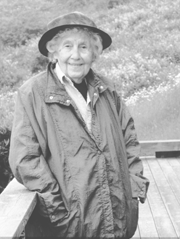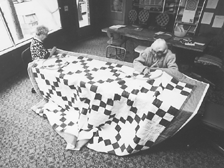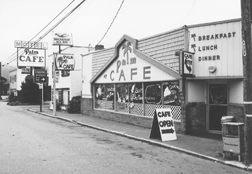

by George Ringwald
I THINK SHE'S WRITTEN THAT COLUMN FOREVER," SAID JACK Durham, editor and publisher of the McKinleyville Press, where Thelma Hufford's Orick Log appears every week.
Not quite. Only since 1974, when she started writing it for the old The Union of Arcata, before that publication "went kerplunk," as Hufford puts it.

Durham, a young man of wit and ebullience, goes on to say: "The only bad thing about Orick, I could have a story `Martians land in Orick' and nobody would know it. She's the only one in the world who writes about Orick. ... Every week is a scoop for Thelma, because nobody else covers it."
Durham, who formerly worked for The Union, remembers, to his rue: "I cut the end of her column once, where she has this little poem, and I learned very quickly you never cut Thelma's poem."
It's not actually a poem as Hufford herself is quick to point out but it's her signature line, a kind of paean to nature. As in: "Leaves on maple trees are red and brown; alder leaves rattle on the ground. ..." or "little killdeer fly about the fields; white egrets stand by the creek; feathery plumes top the pampas grass."
The Orick Log has an old-timey folksy flavor. A meeting of the Redwood Creekers Seniors and Friends last January, for instance, noted who "gave grace," itemized the lunch menu, including "delicious beef stew," and duly named all the committee members serving as well as out-of-town guests.
But it has also carried some honest-to-God scoops. Durham remembers, for example, how Thelma was the first to report a year ago on some controversial proposals in an updating of the general plan for the Redwood National and State Parks.
"Somebody in Orick got hold of an internal memorandum," Durham relates. It proposed, among other things, "to ban fishermen from the beaches and to make a one-way street of the Newton B. Drury Scenic Parkway." Durham adds, "It had the people of Orick really concerned. Thelma wrote about it, and it was a major scoop."
Peter Keller, public affairs officer at Redwood National Park headquarters in Crescent City, admits that the proposals "did create a lot of excitement in the town," but he insists that "those were early drafts; not even drafts, but early brainstorming."
How did they get leaked? "We haven't figured that out yet," he said. At any rate, those controversial proposals are "not under consideration now ... they're totally out." In August and September, he adds, there will be public meetings on a new general management plan for the national and state parks. "We're going to try to get as much public involvement as possible."
To even mention the Redwood National and State Parks, which virtually encircle Orick, is like waving a red flag in front of Thelma Hufford.
"Oh, that whole park system!" she exclaims. "You know, there used to be Genghis Khan running wild, then the Romans, then the Church, and right now we're in between big corporations and the Department of Interior."
As a chronicler of Orick history and herself a resident of the community for 54 of her 84 years, Hufford is, of course, a member of the Orick Historians and Quilters, and it is at one of their weekly Monday meetings that I met her.

"They come at 10," she says of others in the 10-member group, "and I never get there until 11. I do the minutes."
Ruby Jean McNamara, Savina Barlow and Janice Dore are indeed already busily quilting at 10 a.m. that Monday, and they obligingly fill me in on the incredible boom days of Orick that came on the heels of World War II and stretched out to the mid-1960s.
Twenty-one lumber mills were scattered around the valley, from the Humboldt County line on the north to Big Lagoon on the south. More than 20 dairy farms, which even kept a cheese factory going. More than 300 children in the Orick School (kindergarten through eighth grade) so many they had to run double shifts. At least five churches, "and I don't know how many gasoline stations," as Thelma Hufford recalls. Plus five bars. And of course the town's showplace, the 320-seat Orick Theater, run by Robert and Ruby Jean McNamara.
"We used to fill up every Saturday for the first show," notes Mrs. McNamara. (It was the era of double features.)
Promptly at 11 on that Monday morning, Thelma Hufford walks in. She has short white hair and wears thick black-rimmed eyeglasses. She is dressed in Orick casual pants, loose-fitting shirt and sneakers. Her wrists are adorned with silver bracelets.
She too recalls the days of the packed school house; she taught there for 16 years.
In her no-nonsense way, she says: "They weren't all these hyper kids they have today. And that's when the teachers lived here."
Nancy Saemmer, superintendent/principal of the Orick School (where she started as a teacher 10 years ago), in a later interview, readily acknowledges that it's "a very sore point for the community" that she and the school's four full-time teachers don't live in Orick.
"If there was suitable housing," she says, "I would live here."
But Saemmer, who lives in McKinleyville, also notes: "I'm here (at the school) between nine and 12 hours a day, and I feel I am part of the community. This is a wonderful place I wouldn't have taught here if it weren't. If only there were any way to upgrade the housing. ..."
Orick, an anglicized version of the early-day Oreq-w Indian village at the mouth of Redwood Creek, which runs through town, straddles both sides of Highway 101 40 miles north of Eureka. Your proverbial wide spot in the road, it may well seem to motorists whizzing through. It's been called worse. Quilter Janice Dore notes, not very happily, that "one writer called us a `drab little hamlet.'"
Mention those motorists speeding through town, and you touch another sore point with the Historians and Quilters.
"Oh, they drive like crazy through here!" Thelma Hufford says. "And Orick Community Services District, the Orick School and the Orick Economic Development Corp. have all tried to have the California Highway Patrol come here and do something about the speeding, but they're not able to get anything done."
In truth, surrounded by forest-green foothills, with the Pacific Ocean frothing at the sand of the Freshwater Spit just south of town, and the Ladybird Johnson redwood grove a few miles north of town, Orick has one of the county's loveliest scenic settings.
But it is also, sadly enough, a town on its uppers.
A population estimated at 2,500 in its heyday has dwindled to 650, according to the official sign at the southern entrance to town. Unofficially, the locals will tell you, it's barely half that.
What's more, a depressingly high number of the residents today are on welfare. The poverty rate is most readily apparent at Orick School, where 72 percent of the children get either free or reduced-rate meals. Principal Saemmer says that "at least 50 to 60 percent" of their parents are welfare recipients.
She adds: "This (past) year we had an incredible mobility rate 50 percent of the families moving in and out. We have fewer and fewer stable families, families that have grown up here."
(The original front part of the school was built in 1936, and with constant additions over the boom years, Orick now has, as Saemmer says, "a big school here for 64 kids.")
In Orick's decline, the number of dairy ranches has gone from as many as 25 to just three, by Thelma Hufford's count, and the cheese factory is of course long gone. Only one lumber mill is left (Arcata Redwood Co.'s Mill A, on Bald Hills Road north of town). School enrollment sank from a one-time high of 300 to as low as 58 at one point, as oldtimer Bob McNamara remembers. There's only one bar left apparently the watering holes exited along with the loggers. And the movie house has been closed since 1963.
"We opened on New Year's Day 1948," recalls McNamara. "First show was `Ride the Pink Horse.' Seventeen minutes after the door was opened, the place was filled." The McNamaras paid off their $72,000 investment in just five years.
Amazingly, the theater inside still looks in near-mint condition. What was once the theater's ice cream and soda fountain room is now used by the Historians and Quilters for their Monday meetings.
The McNamaras also own the Post Office building across the road and the Village Pantry next door. They also built and owned the Palm Cafe, next door to the theater, but they've since sold it, and Bob McNamara says they're now thinking of selling the theater building.

The decline of Orick began, as Thelma Hufford reports, "when they began mechanizing in the woods and in the mills; a lot of the mill workers and loggers were being replaced by big machinery."
The devastating flood of 1964, which turned Redwood Creek into a raging river, hastened the exodus, and the creation of Redwood National Park in 1968 also gets some of the blame.
"At first, I thought it was a great thing," says Hufford. "Everybody here thought, how wonderful for Orick. We'll have the tallest redwood trees here, we'll have a Redwood National Park, and it will help Orick. But, lo and behold, when they established the park, they put the headquarters in Crescent City! Which had nothing to do with the redwoods here."
The park headquarters was located in Crescent City, PR man Keller explains, because Don Clausen, congressman for the district at the time and a former member of Del Norte County's Board of Supervisors, helped pass the legislation establishing the park. He also notes that Crescent City donated the land for the headquarters site.
When the park was established Oct. 2, 1968, Congress limited its land to 58,000 acres. Ten years later it allowed an expansion to 106,000 acres. Today the Redwood National and State Parks (they agreed to cooperative management of their four North Coast redwood parks in 1994) sprawl across 105,516 acres.
"Little by little, they're acquiring more and more land," grumps Thelma Hufford. And that, as Jack Durham, her editor at the McKinleyville Press, notes, is hurting Orick in the pocketbook, taking away sorely needed county tax money for the school and the Orick Community Services District.
Thelma says: "They're just taking more and more land, and they're not working with the community; they don't help the community at all."
Orick's principal economic source today would appear to be the burl shops strung along both sides of the highway through town. But they too are a sore spot with the Historians and Quilters.
"We have too many burl places," said Savina Barlow.
"And they're not local people," chimed in Ruby Jean Barlow.
Thelma Hufford is predictably more blunt.
"I don't like the way these wood carvers have their stuff all along the highway," she says. "They say it's redwood burl. It's not redwood burl; they're just old roots that they have collected. And of course the tourists don't know the difference."
That Hufford bluntness may cut across the grain with some of her targets, but it also wins her some friends too. Joe Romanini, a rancher who's lived in the town since 1927, told me: "You know what I like about Thelma? She tells you what she thinks."
Her reporting also is appreciated.
As school Principal Saemmer remarked: "I love it! We're so busy working here, we probably wouldn't get anything in the paper if it weren't for Thelma."
Born in northern Minnesota, in the little town of Middle River, Thelma Pesola came by a circuitous route to the North Coast of California: Traveling with her parents to Tennessee, then west to Seattle, to San Francisco, to Fort Bragg, then back north to Eureka, where she went through junior high and high school (as well as Humboldt State University in Arcata) with a good friend named Eleanor Brown. That friend just happened to come from Orick and just happened to be a remote cousin of a man who worked as a county road foreman there.
"And that's how come I met Elmer Hufford," Thelma relates.
They were married shortly after Pearl Harbor day in 1941. He was 32, five years older than Thelma. "We weren't kids anymore."
She shows me a picture of her husband, who died in 1976.
"He was 6 feet 4 and handsome," she says. "Oh, my goodness, he was handsome! It took me five years to get over my husband's death I adored that man!"
After World War II which Elmer Hufford spent with the Army Engineers in Europe while Thelma went to Berkeley, living with her parents and working as a typist in the Santa Fe railroad freight office they came back to the Hufford ranch, at the end of Hufford Road, and Elmer Hufford went into the sand and gravel business as his father before had done. Now that business has been handed down in turn to Elmer and Thelma's son, Joe.
Huffords seem to spring up all over the place in Orick.
Joe Hufford is a member of the Orick Economic Development Corp. So is Thelma. Joe's wife, Donna, is president of the Orick Chamber of Commerce. The three of them are also active in something called the Prairie Creek Fish Hatchery Conversion Advisory Committee, and Thelma also finds time to work with the Orick Rodeo Committee.
(Thelma waxes lyrical in telling about Donna's beautiful singing voice.)
Thelma now lives by herself in the beautiful redwood home near the top of the hill on the Hufford ranch that she and Elmer moved into in January 1968.
"It's solid redwood," she says. "You couldn't buy it anymore." A massive fireplace of Arizona flagstone rises from the living room floor to the loft above. From the deck outside, there's a spectacular view of Redwood Creek and the ocean.
She doesn't lack for company in this seemingly isolate setting. Joe and Donna live just down the hill. Granddaughters Kimberly and Kristina, also living on the Hufford ranch, come by to help Thelma with some of the heavier work, as does grandson Gregory, who's now in high school. Besides that, she has two horses, the braying donkey Nellie, "who's sure smart," "a dumb dog" and two "outside cats."
And of course she keeps busy with the Orick Log, which she started writing "right away" after quitting her teaching job in 1974. (Two years later, however, she took on another job, as secretary for the Orick Community Services District, which she held for 16 years.)
Her writing cubbyhole off the living room and kitchen is one big mass of papers, books, electric typewriter and assorted clippings the kind that oldtime writers and editors thrive in.
"It gets me out," she says of the writing. "Otherwise, I don't know what I'd do. All I write about is Orick, and there's a lot here to write about."
As she puts it: "The history stuff never ends."
Thelma Hufford herself is a part of that history.